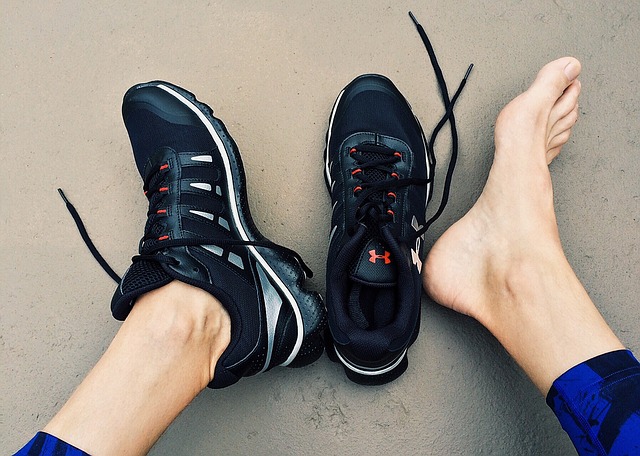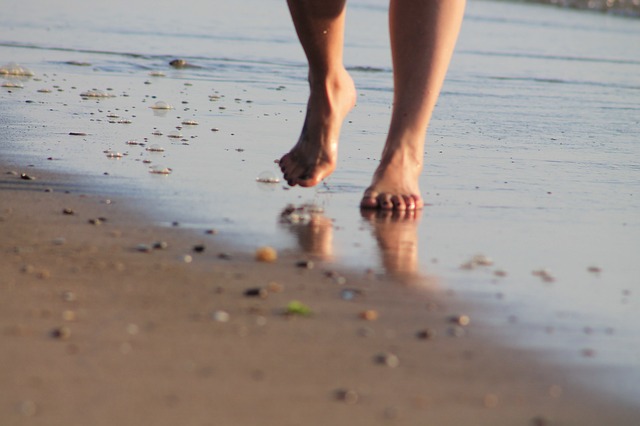I crested the top of the hill, the hot summer sun beating on my bare shoulders. I had just finished my eighth hill repetition on a narrow, winding trail near my home town of Lexington, MA.

If you want to cure Plantar Fasciitis, a holistic treatment is needed
It was August, 2004. I was running close to 80 miles a week and preparing for the fall cross country season of my Junior year at Connecticut College. My mileage had almost doubled since my spring training in outdoor track.
Running a hill workout before cross country season officially starts is aggressive. But I was seeking massive improvement. I was leaving no stone unturned:
- Weekly mileage was near the highest it has ever been
- Workouts started earlier
- Cross-training amounted to hours per week
- Barefoot running was strategic
All that hard work was paying off. I felt great and was in the best shape of my life.
But two days after my hill workout, my right foot developed a burning pain from the heel to my forefoot. After a visit to a specialist, and later a physical therapist, I was delivered the bad news.
I had plantar fasciitis. One of the worst injuries a runner can get. And my season started in less than a month. My hopes for making the varsity squad were threatened, along with my goal of breaking 27 minutes for 8k. I immediately had one goal: cure my plantar fasciitis.
I did what I always did when I got an injury: I immediately took a week off from running. Fortunately, I was able to visit a physical therapist twice a week who massaged my plantar fascia and performed the standard treatment of heat, massage, and ice. It didn’t work well as it took me weeks to get back into a regular running routine.
That experience led me to take a more systematic approach to injuries. Rest, heat, and ice may feel good but they’re not treating the underlying cause of plantar fasciitis. I started doing research on plantar fasciitis and realized…
…I needed a far better treatment than what I was getting at the physical therapist’s office.
How to Cure Plantar Fasciitis
After my experience trying to cure plantar fasciitis seven years ago, I’ve managed to run more, run faster, and become more minimalist – all without a single complaint from either plantar fascia.
It’s not luck – it’s a systematic plan for prevention that includes general strength, specific exercises, and a training upgrade. And I’m predisposed to foot injuries because of my low arches and over-pronation. I’m not a model of biomechanical efficiency – but I do the best I can with what I have.
First, if you happen to have plantar fasciitis, all hope is not lost. Depending on the severity of the injury, you may be able treat it and be back running with 3-7 days if your injury isn’t too severe. Within two weeks, you should be back to your normal training.
Follow these steps if you come down with a case of plantar fasciitis and you can cut your recovery time down substantially. Just keep in mind that this is not a formal treatment protocol – but rather a collection of strategies to help you recover. Our detailed treatment protocol is here in our Injury Prevention for Runners program.
First, just because you can’t run doesn’t mean that you’re not exercising! Stay current with your general strength and begin adding foot and lower leg exercises to improve the strength and function of your feet.
The next step is to massage the underside of your foot:
- When you finish the foot exercises, use a golf ball or lacrosse ball to roll the underside of your foot. There is no “best way” to do this – just feel around your arch and plantar fascia and aggressively massage any area that’s sore or feels “crunchy” (this is scar tissue – break it up!). You should be aggressive but don’t roll so hard that you’re in pain. Find a balance.
- Use your foam roller to roll your soleus and calf muscles. Tightness here can aggravate plantar fasciitis.
- While I don’t have experience with a night splint, many runners have found them helpful. Experiment with what works for you.
- Your body is healing itself, so help it out by eating a nutrient filled diet and getting a lot of sleep.
This routine is far more aggressive than what the majority of runners do for an injury. It also rivals the recovery protocols of most physical therapists. And it’s more effective at getting you back on the road and running sooner.
For an even more detailed, step-by-step rehabilitation protocol to cure plantar fasciitis, see Injury Prevention for Runners (it also includes comprehensive treatment protocols for Achilles Tendinopathy, IT Band Syndrome, runner’s knee, muscle strains, and shin splints).
Once you start running again, take care to limit your faster workouts during the first week. Your plantar fascia will first be able to handle running slowly – then it’ll be ready for more intensity.
When you start running, you should continue to massage your foot with a golf or lacrosse ball and foam roll your soleus and calf to break up residual scar tissue and keep the area supple.
It will also be a smart idea to keep doing the foot exercises 2-3 times per week to ensure you’re staying strong.
Plantar Fasciitis Prevention Strategies

If you don’t have plantar fasciitis (PF), or if you’ve had it in the past and want to remain healthy now, certain prevention tactics are worth doing on a regular basis.
Many of these strategies will not only help prevent PF, but make you a more injury-resistant runner in general (and may even make you stronger, faster, and more attractive…or something like that).
- Run barefoot strides 2-3 times per week on a synthetic turf or smooth grass field. PF is often caused by a weakness of the foot and lower leg musculature – barefoot work helps strengthen your feet.
- You can also do some easy barefoot running at the end of a typical distance run. Limit yourself to 2-10 minutes depending on your fitness level, weight, and experience with barefoot running. A little bit goes a long way.
- Embrace your foam roller and golf ball like good friends! If you’re more sore than usual, spend 5-10 minutes rolling out the soreness. Chronically tight muscles (the opposite of being supple) can lead to injury if you don’t take care of them properly.
- Make a slow transition to wearing more minimalist shoes. Note that I’m not recommending you do your runs in FiveFingers or racing flats. But the vast majority of runners don’t need bulky motion-control or stability shoes unless there’s a prominent biomechanical problem. Odds are, that’s not you. Note: see our running shoe reviews page for shoe ideas plus recommendations for more minimalist casual shoes. Shoes with very high heels (for both men and women) should be worn in strict moderation.
- Beware of too much running on a road’s camber, or its slope toward the curb. When you always stay on the left side of the road (which is the safest way to run – toward traffic), your feet are always slightly tilted to the left which can result in a huge number of problems. Get on the sidewalk, switch sides if traffic permits, or better yet….
- Start trail running! The undulating terrain, roots and rocks, and uneven surface stresses your feet in many different ways. Unlike the road, which is a much more predictable surface, trails aren’t as likely to contribute to overuse injuries.
- If you can’t do any barefoot work or lack access to a trail system, keep up with the foot exercises mentioned above. You need a way to develop additional strength in your feet and lower legs.
- Of course, no injury discussion is complete without this reminder: don’t run too much, too soon, too fast. Recognize your limits and be cautious about how and when you add mileage and intensity to your program. If you don’t know where to start, be safe and sign up for our prevention series so you don’t have to worry.
Naturally, different things will work better for different runners. It depends on why you developed PF in the first place, your stride pattern, and training history. Experiment with both the recovery routine outlined above and the prevention strategies.
Barefoot strides can sometimes be confusing, so here’s a helpful video:
Remember, a runner who only runs is bound to get hurt. The strength work, self-massage, and training variety will do wonders in keeping you healthy over the long-term.
Curing Plantar Fasciitis: The Next Step

Of course, a random collection of treatment ideas is not a formal treatment protocol. If you’ve ever seen a physical therapist, you know there’s a method to treating injuries!
My experience with injuries, seeing countless physical therapists, having 10+ coaches myself, and my own coaching education has given me a strong view on injury prevention and treatment.
I’ve included all of the lessons I learned here – and I’ve made them available for anybody.
Feedback from other runners like you has been humbling:
“Thank you so much for helping me heal the right way the past month. My hips have never been this strong. Ever! All the kinks I’ve had for so long do not exist anymore and I am enjoying my runs so much more now. And… running sub 8:00’s easily! Anyway… I never thanked you so… thank you!” –Sarah
“As a physical therapist I am totally on board with your advice. In particular the strategies for prevention. A must read for any runner.” –Dave
“I am an experienced trainer, coach, and post rehabilitation specialist and have to say that your exercise selections are spot on with what I use with clients. They work, I have seen them work first hand!” –Nick
“I wanted to say a big thank you because following my injury, I’ve been using your injury prevention program and just raced a 10K with a PR! 41:31, fun to win the overall and also finish my last mile at6:23. I look forward to many of your training plans in the future! You can add in the challenges of being a mama to twins… Many a running mother can relate! Thank you so much.” –Jessica
These runners aren’t outliers – there are more examples here.
Ready to dive in for yourself?
These “little things” maybe aren’t so little. After all, they enable you to run consistently and ultimately, healthier and faster. Implement these plantar fasciitis treatment tips and you might be on your way to healthy, pain-free running!
Did you find this post helpful? Go on, spread the love and share it with your running friends!